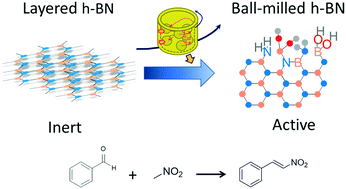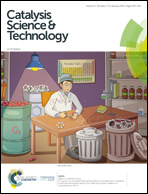Effects of ball-milling treatment on physicochemical properties and solid base activity of hexagonal boron nitrides
Abstract
Hexagonal boron nitride (h-BN) was ball-milled at various rotation speeds (150–600 rpm) using a planetary ball-mill. Ball-milling disrupted the layered structure of the h-BN, resulting in significant increases of surface area. Ball-milling at 400 rpm gave the highest surface area of 412 m2 g−1 while higher rotation speeds decreased the surface areas due to agglomeration. Moreover, ball-milling resulted in the emergence of amino- and hydroxyl groups on the surface which were observed by Fourier transform infrared spectroscopy, and partial oxidation of the surface boron by the formation of B–OH groups was confirmed by X-ray photoelectron spectroscopy. The appearance of trigonal B–O and tetrahedral B–O was observed by boron-11 magic-angle spinning nuclear magnetic resonance spectroscopy. The number of base sites was increased with the increase of rotation speeds of milling, corresponding to the formation of amino groups. The ball-milled h-BN showed catalytic activity for the nitroaldol reaction between nitromethane and benzaldehyde in which the h-BN milled at 400 rpm exhibited the highest reaction rate and turnover frequency. In addition, the ball-milled h-BN could convert glucose with the formation of fructose at 40 °C whereas pristine h-BN showed no activity. The base sites were mainly responsible for the catalytic activity.



 Please wait while we load your content...
Please wait while we load your content...